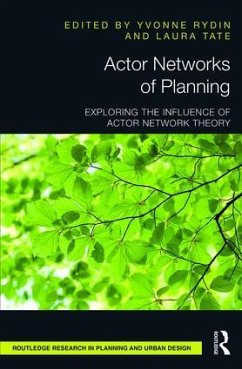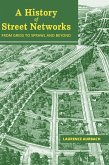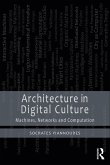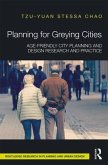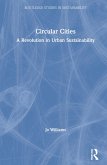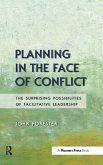Actor Networks of Planning
Exploring the Influence of Actor Network Theory
Herausgeber: Rydin, Yvonne; Tate, Laura
Actor Networks of Planning
Exploring the Influence of Actor Network Theory
Herausgeber: Rydin, Yvonne; Tate, Laura
- Gebundenes Buch
- Merkliste
- Auf die Merkliste
- Bewerten Bewerten
- Teilen
- Produkt teilen
- Produkterinnerung
- Produkterinnerung
This book brings together an international range of contributors to explore such potential of Actor Network Theory (ANT) in more detail.
Andere Kunden interessierten sich auch für
![A History of Street Networks A History of Street Networks]() Laurence AurbachA History of Street Networks24,99 €
Laurence AurbachA History of Street Networks24,99 €![Architecture in Digital Culture Architecture in Digital Culture]() Socrates YiannoudesArchitecture in Digital Culture149,99 €
Socrates YiannoudesArchitecture in Digital Culture149,99 €![A History of Street Networks A History of Street Networks]() Laurence AurbachA History of Street Networks19,99 €
Laurence AurbachA History of Street Networks19,99 €![Planning for Greying Cities Planning for Greying Cities]() Tzu-Yuan Stessa ChaoPlanning for Greying Cities168,99 €
Tzu-Yuan Stessa ChaoPlanning for Greying Cities168,99 €![Planning Los Angeles Planning Los Angeles]() Planning Los Angeles196,99 €
Planning Los Angeles196,99 €![Circular Cities Circular Cities]() Jo WilliamsCircular Cities168,99 €
Jo WilliamsCircular Cities168,99 €![Planning in the Face of Conflict Planning in the Face of Conflict]() John ForesterPlanning in the Face of Conflict177,99 €
John ForesterPlanning in the Face of Conflict177,99 €-
-
-
This book brings together an international range of contributors to explore such potential of Actor Network Theory (ANT) in more detail.
Produktdetails
- Produktdetails
- Verlag: Routledge
- Seitenzahl: 270
- Erscheinungstermin: 1. März 2016
- Englisch
- Abmessung: 240mm x 161mm x 19mm
- Gewicht: 573g
- ISBN-13: 9781138886407
- ISBN-10: 1138886408
- Artikelnr.: 43678189
- Herstellerkennzeichnung
- Libri GmbH
- Europaallee 1
- 36244 Bad Hersfeld
- gpsr@libri.de
- Verlag: Routledge
- Seitenzahl: 270
- Erscheinungstermin: 1. März 2016
- Englisch
- Abmessung: 240mm x 161mm x 19mm
- Gewicht: 573g
- ISBN-13: 9781138886407
- ISBN-10: 1138886408
- Artikelnr.: 43678189
- Herstellerkennzeichnung
- Libri GmbH
- Europaallee 1
- 36244 Bad Hersfeld
- gpsr@libri.de
Yvonne Rydin, Professor of Planning, Environment and Public Policy, Bartlett School of Planning, University College London, UK. Laura Tate, PhD, Principal of Laura Tate Associates, a City and Social Planning and Evaluation Consulting firm based in Victoria and Vancouver, British Columbia, Canada.
Introduction
1. Exploring the Influence of ANT (Yvonne Rydin and Laura Tate)
PART A: Using ANT: Applied Planning Analyses
2. Constructing "Green Building": Heterogeneous Networks and the Translation of Sustainability into Planning in Israel (Shula Goulden)
3. Planned Derailment for New Urban Futures? An Actant Network Analysis of the "Great [Light] Rail Debate" in Newcastle
Australia (Kristian Ruming
Kathleen Mee and Pauline McGuirk)
4. Grants as Significant Objects in Community Engagement Networks: Kelowna
British Columbia (Silvia Vilches and Laura Tate)
5. Assembling Localism: Practices of Assemblage and Building the "Big Society" in Oxfordshire
England (Sue Brownill)
6. Two Exemplar Green Developments in Trondheim
Norway: Tales of Qualculation and Non Qualculation (Thomas Berker and Stig Larss¿ther)
7. Unpacking the Swedish Urban Sustainable Imaginary: at the World Expo
Shanghai
China (Anna Hult)
8. Relationships of the Material
Cultural and Political in the Redesign of Stortorget
Malmö
Sweden (Mattias Kärrholm)
9. Assembling Energy Futures: Seawater District Heating in The Hague
Netherlands (Simon Guy
Graeme Sheriff
Chris Goodier and Ksenia Chmutina)
PART B: The Way Forward: Innovative Practices and Theoretical Controversies
10. Can Actor Network Theory Provide a Theory of Action? Planning in New York
USA (Robert Beauregard and Laura Lieto)
11. "Emergent places": Innovative Practices in Zurich
Switzerland (Joris Van Wezemael and Jan Silberberger)
12. Applications within Urban Living Labs of Flanders' N16 corridor
Belgium (Luuk Boelens and Marleen Goethals)
13. Hydro-Urbanism in London: Using Co-evolutionary Actor Network Theory as a Prospective Methodology (Tse-Hui The)
14. Towards an Extended Symmetry: using ANT to Reflect on the Theory and Practice Gap (David Webb)
15. "A Grand Question of Design": Knowledge
Space and Difference in Early and Late Latour (Malcolm Tait and Kiera Chapman)
1. Exploring the Influence of ANT (Yvonne Rydin and Laura Tate)
PART A: Using ANT: Applied Planning Analyses
2. Constructing "Green Building": Heterogeneous Networks and the Translation of Sustainability into Planning in Israel (Shula Goulden)
3. Planned Derailment for New Urban Futures? An Actant Network Analysis of the "Great [Light] Rail Debate" in Newcastle
Australia (Kristian Ruming
Kathleen Mee and Pauline McGuirk)
4. Grants as Significant Objects in Community Engagement Networks: Kelowna
British Columbia (Silvia Vilches and Laura Tate)
5. Assembling Localism: Practices of Assemblage and Building the "Big Society" in Oxfordshire
England (Sue Brownill)
6. Two Exemplar Green Developments in Trondheim
Norway: Tales of Qualculation and Non Qualculation (Thomas Berker and Stig Larss¿ther)
7. Unpacking the Swedish Urban Sustainable Imaginary: at the World Expo
Shanghai
China (Anna Hult)
8. Relationships of the Material
Cultural and Political in the Redesign of Stortorget
Malmö
Sweden (Mattias Kärrholm)
9. Assembling Energy Futures: Seawater District Heating in The Hague
Netherlands (Simon Guy
Graeme Sheriff
Chris Goodier and Ksenia Chmutina)
PART B: The Way Forward: Innovative Practices and Theoretical Controversies
10. Can Actor Network Theory Provide a Theory of Action? Planning in New York
USA (Robert Beauregard and Laura Lieto)
11. "Emergent places": Innovative Practices in Zurich
Switzerland (Joris Van Wezemael and Jan Silberberger)
12. Applications within Urban Living Labs of Flanders' N16 corridor
Belgium (Luuk Boelens and Marleen Goethals)
13. Hydro-Urbanism in London: Using Co-evolutionary Actor Network Theory as a Prospective Methodology (Tse-Hui The)
14. Towards an Extended Symmetry: using ANT to Reflect on the Theory and Practice Gap (David Webb)
15. "A Grand Question of Design": Knowledge
Space and Difference in Early and Late Latour (Malcolm Tait and Kiera Chapman)
Introduction
1. Exploring the Influence of ANT (Yvonne Rydin and Laura Tate)
PART A: Using ANT: Applied Planning Analyses
2. Constructing "Green Building": Heterogeneous Networks and the Translation of Sustainability into Planning in Israel (Shula Goulden)
3. Planned Derailment for New Urban Futures? An Actant Network Analysis of the "Great [Light] Rail Debate" in Newcastle
Australia (Kristian Ruming
Kathleen Mee and Pauline McGuirk)
4. Grants as Significant Objects in Community Engagement Networks: Kelowna
British Columbia (Silvia Vilches and Laura Tate)
5. Assembling Localism: Practices of Assemblage and Building the "Big Society" in Oxfordshire
England (Sue Brownill)
6. Two Exemplar Green Developments in Trondheim
Norway: Tales of Qualculation and Non Qualculation (Thomas Berker and Stig Larss¿ther)
7. Unpacking the Swedish Urban Sustainable Imaginary: at the World Expo
Shanghai
China (Anna Hult)
8. Relationships of the Material
Cultural and Political in the Redesign of Stortorget
Malmö
Sweden (Mattias Kärrholm)
9. Assembling Energy Futures: Seawater District Heating in The Hague
Netherlands (Simon Guy
Graeme Sheriff
Chris Goodier and Ksenia Chmutina)
PART B: The Way Forward: Innovative Practices and Theoretical Controversies
10. Can Actor Network Theory Provide a Theory of Action? Planning in New York
USA (Robert Beauregard and Laura Lieto)
11. "Emergent places": Innovative Practices in Zurich
Switzerland (Joris Van Wezemael and Jan Silberberger)
12. Applications within Urban Living Labs of Flanders' N16 corridor
Belgium (Luuk Boelens and Marleen Goethals)
13. Hydro-Urbanism in London: Using Co-evolutionary Actor Network Theory as a Prospective Methodology (Tse-Hui The)
14. Towards an Extended Symmetry: using ANT to Reflect on the Theory and Practice Gap (David Webb)
15. "A Grand Question of Design": Knowledge
Space and Difference in Early and Late Latour (Malcolm Tait and Kiera Chapman)
1. Exploring the Influence of ANT (Yvonne Rydin and Laura Tate)
PART A: Using ANT: Applied Planning Analyses
2. Constructing "Green Building": Heterogeneous Networks and the Translation of Sustainability into Planning in Israel (Shula Goulden)
3. Planned Derailment for New Urban Futures? An Actant Network Analysis of the "Great [Light] Rail Debate" in Newcastle
Australia (Kristian Ruming
Kathleen Mee and Pauline McGuirk)
4. Grants as Significant Objects in Community Engagement Networks: Kelowna
British Columbia (Silvia Vilches and Laura Tate)
5. Assembling Localism: Practices of Assemblage and Building the "Big Society" in Oxfordshire
England (Sue Brownill)
6. Two Exemplar Green Developments in Trondheim
Norway: Tales of Qualculation and Non Qualculation (Thomas Berker and Stig Larss¿ther)
7. Unpacking the Swedish Urban Sustainable Imaginary: at the World Expo
Shanghai
China (Anna Hult)
8. Relationships of the Material
Cultural and Political in the Redesign of Stortorget
Malmö
Sweden (Mattias Kärrholm)
9. Assembling Energy Futures: Seawater District Heating in The Hague
Netherlands (Simon Guy
Graeme Sheriff
Chris Goodier and Ksenia Chmutina)
PART B: The Way Forward: Innovative Practices and Theoretical Controversies
10. Can Actor Network Theory Provide a Theory of Action? Planning in New York
USA (Robert Beauregard and Laura Lieto)
11. "Emergent places": Innovative Practices in Zurich
Switzerland (Joris Van Wezemael and Jan Silberberger)
12. Applications within Urban Living Labs of Flanders' N16 corridor
Belgium (Luuk Boelens and Marleen Goethals)
13. Hydro-Urbanism in London: Using Co-evolutionary Actor Network Theory as a Prospective Methodology (Tse-Hui The)
14. Towards an Extended Symmetry: using ANT to Reflect on the Theory and Practice Gap (David Webb)
15. "A Grand Question of Design": Knowledge
Space and Difference in Early and Late Latour (Malcolm Tait and Kiera Chapman)

